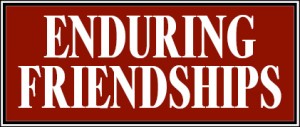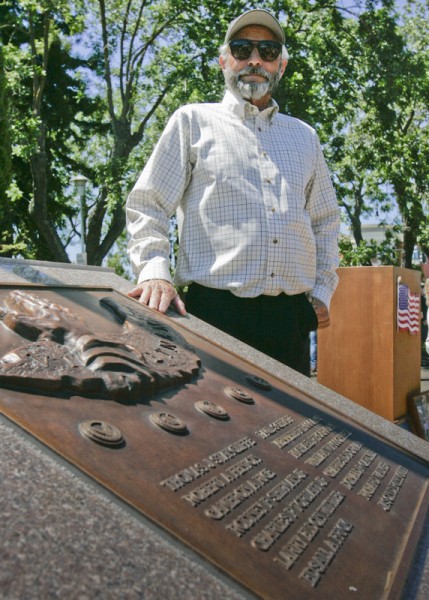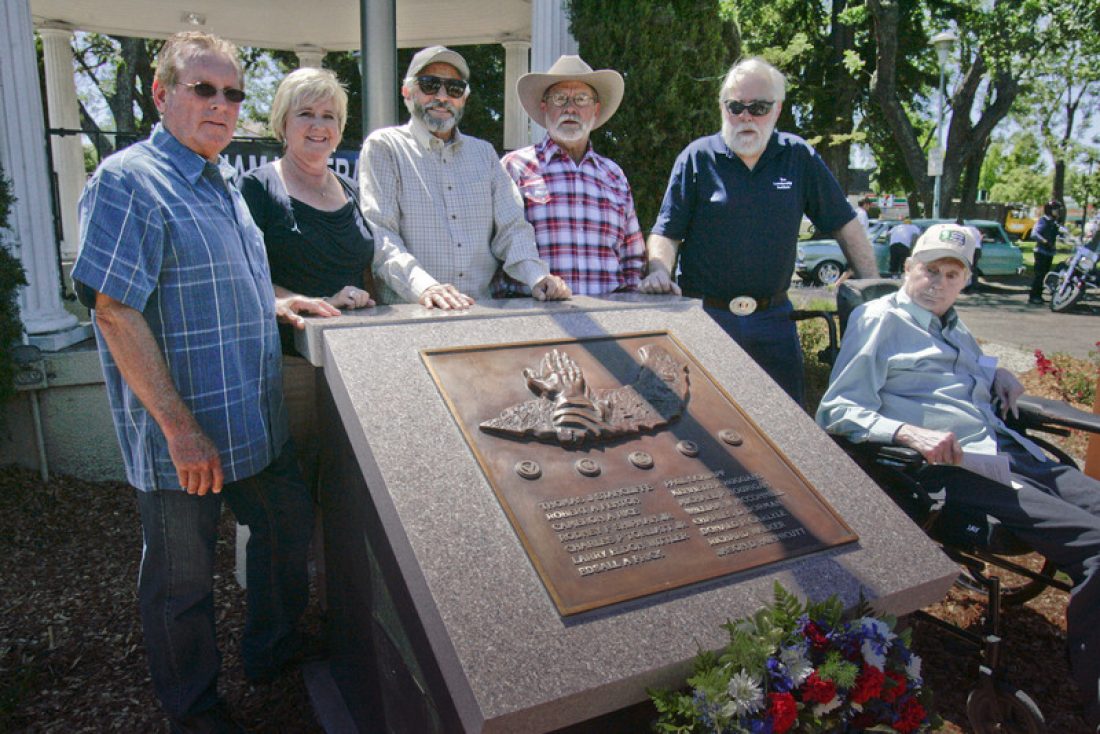By KATIE WATTS / Petaluma Towns Correspondent
“The first time I heard the word Vietnam was 1964,” said Ed Hergert. He grew up in Petaluma and remembers the crowded, split sessions required to cram Baby Boomer students into Kenilworth Junior High before Petaluma Junior High was built.
Those overflowing classrooms brought together students from the east and west sides, but it wasn’t until they entered Petaluma High that the “amazing bonding through all the classes started.”
George Lucas made a movie about that time, “American Graffiti.” “They filmed it here,” said Hergert. But while Lucas’ inspiration was his hometown of Modesto, Petaluma had the same small town feel. “We grew up together,” Hergert said, and the heart of the action for his and his friends was in Walnut Park, especially on Friday and Saturday nights when they piled into friends’ cars and cruised the Boulevard.
“I knew so many seniors in the class of ‘66,” Hergert said. “I was class of ‘67. We were all going to join the Marines, go over there and kick some ass.”
But when he was getting ready to graduate, letters began coming home from those who had gone to Vietnam. They all said the same thing, Hergert said. “Don’t do it, don’t join up.”
 By 1968, the year “all hell broke loose, we had already lost three or four boys, and I was sick of it,” he said. “‘Nam, ‘Nam, ‘Nam. The country was about to split in half. People were rioting over the war, and the country lost 250 boys in one week. Petaluma lost ten more, and they were my really close friends.”
By 1968, the year “all hell broke loose, we had already lost three or four boys, and I was sick of it,” he said. “‘Nam, ‘Nam, ‘Nam. The country was about to split in half. People were rioting over the war, and the country lost 250 boys in one week. Petaluma lost ten more, and they were my really close friends.”
Her paused and wiped his eyes. “It was so hard. They were boys. One minute we were riding around town in our cars, the next they’re in boot camp. Then they would come back and visit and be shipped off in country — Vietnam.”
He recalled Kenneth Huggans.
“We called him Casey. He was a cowboy-type, a really nice kid, but he didn’t have any direction to his life, so he joined up. I got mad at him, but it was too late. He kept writing me from boot camp not to worry. ‘I’m in artillery, I’ll be sitting on a hill.’ But he got off the airplane, the first patrol put him on point, and he died.”
—————–
The Petaluma boys memorialized by their friends on the Walnut Park plaque are: Thomas Stancliffe, Robert Fenton, Cameron Rice, Rodney Shipman Jr., Charles Torliatt Jr., Larry Wittler, Edsall Frick, Paul Schimpf, Kenneth Huggans, Michael Hourigan, William McConnell, Charles Dorman, Donald Carlyle, Richard Walker, Jason Hunnicutt.
—————–
Hergert and his friends had already gone through three or four military funerals, but after Casey’s death, about 10 of them said, “This is nuts. Let’s do something, put his name someplace.”
They decided on a plaque with the names of all those who had died.
“This was a small town. We didn’t know everyone, but knew of each other. We learned we needed to go to the City Council so we went down and said, ‘We would like to put our friends’ names in the park. They died in Vietnam, and we want to do something for them.’”

Ed Hergert at the dedication for the new Vietnam Veterans Memorial Plaque. (Scott Manchester/ For The Press Democrat)
The City Council had rules and regulations, they learned. Get drawings, give the group a name, have a design, then get permission. The list was daunting, as was raising money, Hergert said. “We walked out feeling like we had been scolded by the Dean of Boys.”
They were stopped by Councilman Phil Joerger, who was sympathetic and said he would help guide them. So the group went back to what Hergert called kitchen table parties to figure out what to do next.
George Estebanez said his mom did sculptures, metal work, bronze. None of them was aware how well-known sculptor Rosa Estebanez was.
She agreed to help and sketched a design they liked, bas relief hands clasped in prayer over an outline of Vietnam. She also suggested a name for the group, “Youth to Youth” and a budget estimate of $600.
“We didn’t have $600. We made $1.25 an hour,” Hergert said wryly.
But Alice and Andrea Bordessa wrapped coffee cans in paper, labeled them Vietnam Memorial Donations and went to local merchants, asking them to display the cans. The newly named group set up a bank account, and then the Argus-Courier got wind of it and did an article.
“The cans filled up, banks were donating money, it was coming in fast,” said Hergert. “Then ranchers and the local farmers began holding barbecues. In maybe two weeks we had more money than we needed.”
The teens went back to the City Council and were told the plaque wasn’t appropriate for Walnut Park. What about the Petaluma Veterans Memorial Building?
The teens refused. Walnut Park was the center of town, “where we would meet on Friday and Saturday nights.” They pointed out the City Council hadn’t originally said Walnut Park was off-limits.
So finally, after what Hergert estimated was six to seven months, the plaque was dedicated on May 30, 1969, the nation’s first, Hergert said. “It was a solemn thing. We wore suits and ties, and it felt like a burial.”
The plaque was stolen in December, 2012, and when he saw the headline in the Press Democrat, “I thought I was going to get sick,” said Hergert, who now lives in Sebastopol.
The next morning he was in Petaluma, telling Liz Cohee and Joe Noriel of the Petaluma Historical Museum and Library that he was one of the original group. He soon found himself leading a group that formed to replace the plaque.
Four members of the original plaque group also donated their time: Hoot Smith, Alice Bordessa Radtkey, Terry Radtkey and Tom Barr.
“The money was coming in like it did in 1969, thousands and thousands of dollars within a few weeks,” Hergert said. Virginia Harrison, Maureen Francis and John Maiden collaborated to recreate Rosa Estebanez’ original design. Hergert also singles out contractor John Vallee, mason Wayne Olderbak and Vietnam veteran Richard Uhr for their work on and support of the new plaque.
Hergert said that again it was suggested the plaque be placed somewhere else, but “Alice, Hoot and I shook our heads and said, ‘No. It stays in Walnut Park.’”
This time it was placed on a pedestal and a flagpole was added. The new plaque was added on May 13, 44 years to the day after the original.
This time Hergert didn’t want suits and ties. He wanted a celebration, so he asked his friend Jim Butler if they could round up some of the old ‘60s hot rods.
“I wanted the theme of the ‘60s and the bright colors of the cars,” he said. “I looked around at the ceremony and realized I hadn’t seen some of these people in 40 years. That was what made it over the top for me.
“Not only were the boys back in the park but here were their friends.”
At the 1969 ceremony, they had been honored as servicemen, Hergert said, “but I wanted them to be honored as Petaluma boys — our friends.”
Read the other stories in Sunday’s Enduring Friendship issue here:
Brought together by daughters in Geyserville
Roommates who have weathered life’s storms in Cloverdale
The Hardware Heaven cronies in Occidental
Bonds made on the rugby field in Santa Rosa
Dog-lovers’ friendship endures beyond death in Windsor
Identical twins still share everything in Sonoma
Reunited by a cause in Petaluma

